Active 1977–present | Type Special Forces | |
 | ||
Nickname(s) GIS, Teste di cuoio ("Leatherheads") | ||
Gruppo di Intervento Speciale (GIS, in English "Special Intervention Group") is an elite airborne special operations counter-terrorism tactical response unit inside the Italian Carabinieri military police, first formed in 1977. In 2004 the GIS evolved into a special forces unit.
Contents
The unit has taken part in counter-terrorism operations and VIP, executive and dignitary protection security details ever since the inception of the GIS.
History
In the fall of 1977, the Carabinieri's HQ decided to establish a CT Unit to counter the growing terrorist phenomena. Few months later, the GIS "Gruppo Intervento Speciale" was born. GIS is the Carabinieri CT unit and it responds directly to the Carabinieri HQ and to the Ministry of Interior. The focus of GIS has always been on very high risk CT operations, such as the storming of hijacked aircraft.
Organization and recruitment
The 150-man GIS has three operational sections and one sniper/reconnaissance team. Every section is divided into a detachment of four men. In every moment there is a section ready to leave the base in 30 min. The sniper team is usually formed by two snipers, equipped with Mauser 86SRs, and by a scout, usually with a semi-automatic H&K PSG/1. During action men alternate in the scout role. Every GIS soldier is a volunteer from the 1st Carabinieri Airborne Regiment "Tuscania". During first selection, all candidates go to an interview with a GIS high officer to verify their motivation, which is a key element. The soldiers who pass the first selections go to a basic course which lasts five months. A great amount of time is devolved to martial arts (Wushu and Thai boxing), explosives, tactics, English language, topography, terrorist ideology, and photography as well as combat shooting. They use FATS (Fire Arms Training System), a laser-system which project on a screen interactive images and can record all students' reactions. Usually during this first course 50% drop out. From those who pass, only the best ones are selected to progress to a six-month-long Specialization Course, after which they become operative members. They are also trained in combat driving (reportedly held at Ferrari's famed factory and speed roadway).
Alliances
GIS has very good relations with many top class CT units in the world, amongst these are Great Britain's SAS, Ireland's ARW & ERU, Spain's GEO and UEI, France's GIGN, American Hostage Rescue Team, Germany's GSG 9 and SEK, Belgium's ESI, Austria's GEK and the Netherlands's DSI.
